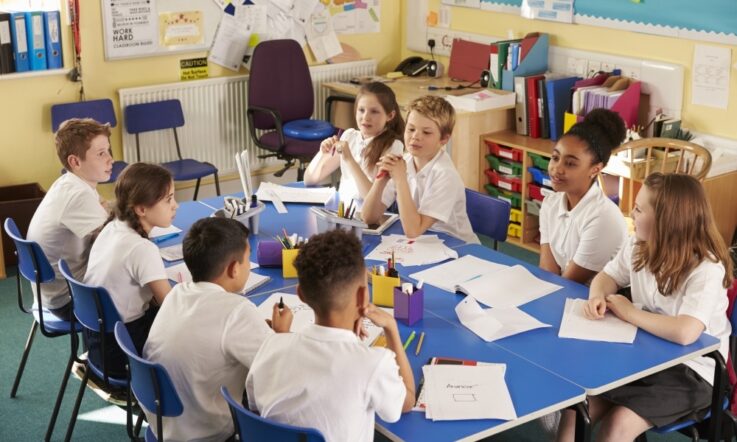All children deserve a healthy foundation for their development and growth, and schools play a crucial role. A new discussion paper (Sahlberg et al., 2023) suggests shifting the core purpose of schools and shares 5 key principles to enhance student wellbeing, learning and happiness.
It has been jointly published by the Melbourne Graduate School of Education (MGSE) at the University of Melbourne, the Centre for Community Child Health at the Murdoch Children’s Research Institute and the Faculty of Education at Southern Cross University.
The paper – authored by Professor Pasi Sahlberg, Professor Sharon Goldfeld, Associate Professor Jon Quach, Caitlin Senior and Cecilia Sinclair – argues Australian schools should focus equally on learning, wellbeing and health.
Lead author Pasi Sahlberg is a professor of educational leadership at the MGSE. He tells Teacher: ‘It is important to keep in mind while discussing this paper with colleagues and teachers that we fully acknowledge how overworked and under-resourced most of our schools, especially public schools, are at the moment.
‘The purpose of our reinvention journey is not to add to that heavy load of duties that teachers and principals have in our schools. Quite the opposite. We are encouraging finding more effective and smarter solutions to enhance everyone’s wellbeing, learning and happiness in school.’
In the paper, Professor Sahlberg and colleagues discuss 5 key principles ‘to improve the wellbeing, health and learning outcomes of every child in every community’.
- A whole child and whole school approach (the organising principle)
- Co-designed, evidence-based and flexible learning and wellbeing approaches
- Health and wellbeing as essential 21st century skills
- Building an engaging culture of health, wellbeing and learning in school
- Relationships and partnerships between services, families and schools in every community
Schools as multi-opportunity communities
The paper says shifting the core purpose of school ‘from primarily focusing on academic intelligence’ would ‘enable schools to be multi-opportunity communities designed to build a healthy foundation for lifelong success.’
Co-author Professor Sharon Goldfeld, Director of the Centre for Community Child Health at the Royal Children’s Hospital and Theme Director of Population Health at the Murdoch Children’s Research Institute, explains a multi-opportunity community is a school that delivers many opportunities for children, of which learning is one aspect.
‘The current school model cannot do this alone, so the question is, what would schools look like if they were multi-opportunity communities caring holistically for children and delivering on their learning, wellbeing and health?’ she tells Teacher.
‘We are looking to build a movement by engaging children, young people, professionals and the public in considering how we might reinvent schools. We think we are on a safe bet that there are many potential ideas out there.’
From principles to practice
The paper explores the case for each key principle and what successful approaches could look like in practice. Relationships and partnerships between services, families and schools reiterates that schools should be able to be thought of as community hubs that collaborate effectively to meet student needs.
What does that look like exactly? ‘This means schools purposefully thinking about the best way to work with the children, families and communities to have children flourish,’ Professor Goldfeld says. ‘This may be thinking about services (bringing services in or making it easier for services to connect with the schools and families), or use of infrastructure (for example, buses to pick up children), or involving different community members (for example, engaging with cultural groups), or thinking laterally about how to engage families (for example, parent classes).’
In the paper, Professor Goldfeld adds, the authors note bright spot schools that have considered how they might be designed to meet the needs of children and parents, and be embedded in the community. One bright spot example is in Victoria, where Disability Inclusion Profiles are being introduced. The strength-based model considers the whole child and their learning in context to ensure they receive the support needed to be successful at school.
Health and wellbeing as essential 21st Century skills involves seeing the learning of digital, socio-emotional, nutritional, mental and physical health and wellbeing skills as an important outcome of school education.
‘Considering health as a skill that all children should learn at school, just like they are expected to learn knowledge and skills in various subjects currently, would shift the focus away from current reactive models of wellbeing towards a more preventive and active model that would support children to develop lifelong attitudes, knowledge, and life skills for a safe, sustainable, and healthy life,’ Professor Sahlberg explains.
Two examples of what this might look like in practice are included in the paper: the new curriculum in Wales, where one of the 4 aims is to produce healthy and confident individuals, and Malpa’s Young Doctors for Life program in Australia.
‘The aim of Welsh schools is to…support every student to have healthy minds and bodies. It means that health and wellbeing are closely interlaced through the other curriculum areas rather than being separate projects or interventions,’ Professor Sahlberg shares. ‘Another good example is our own Malpa’s Young Doctors for Life program that prepares Aboriginal and non-Aboriginal high school students to be young doctors, taking control of their health and creating healthy communities.’
A whole child and whole school approach
Professor Sahlberg emphasises that many schools in Australia are on the move towards more holistic models of teaching and learning. ‘What we are suggesting is therefore not necessarily anything new, just doing more of those little things that help schools to create more holistic approaches in education and health,’ he tells Teacher.
As such, the paper also suggests schools can think about what they’re doing now that already supports a whole child approach and what could be done differently to support that approach as a whole school.
‘A whole school approach could include developing mindsets among school staff that everyone in school, regardless of what subjects teachers teach or what their roles in running the school are, would equally share responsibility for the development of all children,’ Professor Sahlberg says. ‘For example, if I am a mathematics teacher, I should accept broader collective responsibilities in children’s learning and wellbeing than just those of my own students.
‘A whole school, whole child approach means building school cultures that are more collective and inclusive that provide more opportunities to address current inequities in education and health.’
References
Sahlberg, P., Goldfeld, S., Quach, J., Senior, C., & Sinclair, C. (2023). Reinventing Australian schools for the better wellbeing, health and learning of every child (Version 2). Murdoch Children’s Research Institute. https://doi.org/10.25374/MCRI.22766825.v2
Consider the example given by Professor Pasi Sahlberg of a mathematics teacher acting on the understanding of their equal responsibility for the development of all children.
As a teacher, is this something you are already prioritising in your day-to-day practice? If so, how is this approach improving student outcomes?



